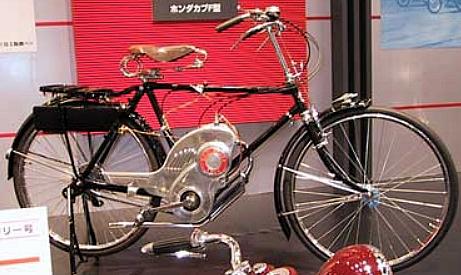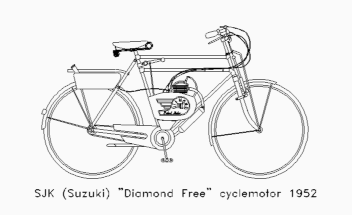 Go to the
Archive index
Go to the
Archive indexThe economic conditions prevailing in Japan in the years immediately after the end of the Second World War gave rise to a demand for cheap, home-produced, personal transport. Much of this need could be satisfied by cyclemotors and several varieties were produced. Many cyclemotors used army surplus engines; the best known of these are probably the early Honda machines. The first Suzuki motor cycles were also built to satisfy this demand but the circumstances surrounding their production were somewhat different from most other Japanese cyclemotor manufacturers.
Michio Suzuki was 64 when he took the decision to start building cyclemotors in 1951. The Suzuki company had started up before WWII in the business of manufacturing looms. The company had to diversify to stay in business after the war and became involved in many forms of light engineering.
The first cyclemotor produced by SJK (Suzuki Jidosha Kogyo) was a 36cc engine called the "Power Free". The engine was a "square" 36mm × 36mm piston-ported two stroke mounted within the cycle frame, just above the pedals. It powered the cycle through the normal pedalling chain and required special chain-wheels to enable the rider to free-wheel while the engine was running. The engine could also be pedal-assisted, or disconnected completely. Unlike most of its competitors, the Power Free did not use army surplus or proprietary engines and was built entirely by Suzuki. Even the carburettor and flywheel magneto were manufactured by Suzuki.

The Power Free was only on sale for a few months before it was substantially improved. The engine capacity was increased to 50cc and a two-speed gear was incorporated.
In 1953 a new model, the "Diamond Free" was introduced. This was built on very similar lines to the Power Free and used the same method on transmission. The engine capacity was now 58cc (43mm × 40mm); neat alloy side panels tidied up the unit's appearance. Power output at 4000rpm was 2bhp.
There were many detail variations during the production of these cyclemotors, particularly in the design of the fuel tank, chain covers and exhaust system. Additionally, a variety of special frames was available, incorporating such features as drum brakes, strengthened or sprung forks, and even crash bars.
The Diamond Free had the usual handlebar controls: a lever operated clutch, a thumb lever for the choke, and a throttle twist-grip. The two-speed gearbox was controlled by a lever mounted on the frame's seat tube.

Although virtually unknown in the West, many thousands of Power Free and Diamond Free machines were sold in Japan. 1954 saw the end of Suzuki's cyclemotors with the introduction of the "Mini Free". This was a 50cc moped, being only sold as a complete machine. It was, however, still very cyclemotor-like in appearance, having a conventional bicycle frame. The engine was mounted ahead of the bottom bracket and a Vee belt from the engine drove a pulley clipped to the spokes of the rear wheel. The Mini Free continued in production until 1958 and a more conventional moped, the "Suzumoped" replaced it.
Suzuki's involvement with both cyclemotors and mopeds stopped in 1959. Since then its under-50cc output has been mainly fixed-footrest machines.
First published - October 1989